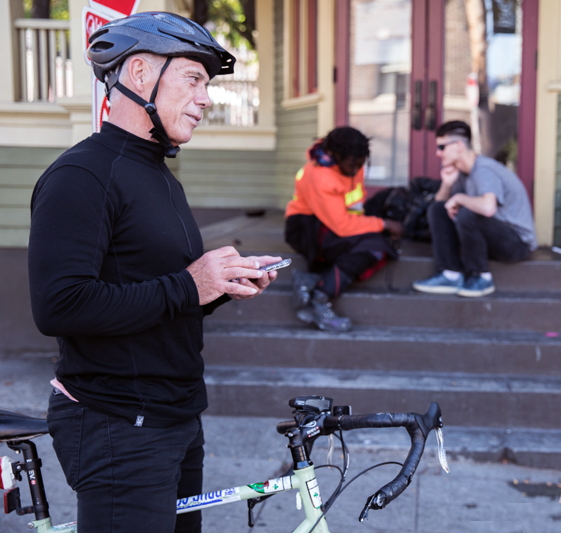DESIGN AND ANIMATION: KELLY FLYNN/SOUND DESIGN: SARA BERNARD/REPORTING: ALLEGRA ABRAMO
SEATTLE — It was after dark when Patrick arrived at a young adult homeless shelter downtown on a cloudy November night in 2018. Patrick, 22 at the time, pulled up in an Uber called by the psychiatric facility where he had spent two weeks after a suicide attempt — not his first. A dark green suitcase held his few belongings: a favorite T-shirt, an Eeyore stuffed animal, photos of friends and a tattered copy of “Alice in Wonderland” he had found at the hospital.

Matt McKnight/Crosscut
Patrick
Patrick, who asked that his real name not be used, had experienced homelessness with his family as a child, but this was his first time staying in a youth shelter. “Actually I felt fine about it when I first got there,” he said, “and then it got progressively scarier for a while.”
He quickly learned a new routine: Wake up at 7 a.m. after a few hours of restless sleep, just in time to stuff a notebook, water bottle, warm clothes and other necessities into a backpack before the shelter closed for the day. Then spend long hours at parks and other public spaces, punctuated by meals and activities at various drop-in centers for homeless youth, before the shelter opened back up around 9 p.m.
Speaking over breakfast at a drop-in center a week after arriving at the shelter, Patrick described his situation as “futile.” In that environment, he said, you don’t have the freedom to pursue your dreams. “You’re not really living a life if you are living here,” he said.
It would be another year before he found an apartment through so-called rapid rehousing, which provides federally funded rental assistance for up to 12 months.
In Washington state, thousands of children and young adults like Patrick experience homelessness soon after exiting psychiatric and substance use disorder treatment.

New Horizons
Angie Merrill
Nearly one-quarter of the roughly 5,200 young people who left Medicaid-funded inpatient care in the state were homeless or unstably housed within a year of discharge, according to a 2017 state report. Those numbers are almost certainly an undercount, since the report included only youth who accessed food, housing or cash assistance programs.
The instability inherent in homelessness makes the long-term project of recovering from mental illness or addiction even more daunting, says Angie Merrill, director of prevention and housing services at the New Horizons youth shelter in Seattle.
“It’s difficult to keep track of medications, let alone other important belongings,” she said. And for those battling addiction, it’s hard to avoid people who are using, as well as other triggers. Experiencing homelessness “really exacerbates whatever behavioral health issue is going on,” she said.
An estimated 13,000 unaccompanied young people ages 12 to 24 access homeless services each year in Washington, according to a 2016 report that relied on multiple data sources due to the difficulty of counting homeless youth. Research shows that young people who experience homelessness are at higher risk of mental illness, dropping out of school and being sexually assaulted and trafficked.
As part of a commitment to address youth homelessness in Washington, state lawmakers vowed in 2018 to halt the pipeline of youth into homelessness from publicly funded systems of care, including mental health and substance use disorder treatment, foster care and juvenile detention. That lofty goal is supposed to be accomplished by the end of 2020.
What’s needed, advocates say, are incentives and funding for inpatient facilities to connect young people with housing specialists before they are discharged, plus more support for youth and their families once they return home. The state also needs more transitional housing options — including clean and sober housing — for those who can’t go back to family.
These ideas are echoed in the state’s recent plan to tackle the issue. But funding to implement most of the recommendations must wait until next year’s budget negotiations. Yet, as the economy reels from the effects of the coronavirus pandemic, it’s unclear whether the Legislature will find the millions needed to make good on its promise of safe and stable housing for youth exiting the state’s care.
‘You have to build something’
As with the broader homelessness crisis, one of the biggest barriers to ensuring young people coming out of treatment don’t wind up homeless is a shortage of affordable and appropriate housing.
Too often, youth and their advocates say, young people return to environments that make staying sober and healthy nearly impossible.
“Nine times out of 10, you are going back to the spot where you were before treatment, and most likely that’s where you were using,” said M., who uses the pronoun they and asked that we use their first initial because of the stigma of homelessness and addiction.
The 20-year-old Texas native recalls leaving a second stint at inpatient treatment for methamphetamine addiction and returning to a young adult shelter in Seattle. The alley outside the shelter is a well-known hot spot for drug use.
“When I first got out of treatment and went back, my first thought was, ‘I can do this,’” M. said. “And I went down the alley with my head held high. But you go back to the alley, you’re using. It’s either going to come to you, or you’re going to it.”

Matt McKnight/Crosscut
Johnny Ohta in 2019
Young adults 18 to 24 years old make up about 85% of all youth who experience homelessness after inpatient mental health or drug treatment, state data shows. That age group, in particular, lacks emergency housing where they don’t get kicked out at 7:30 a.m., says Johnny Ohta, a chemical dependency counselor for homeless youth with Ryther, a mental health agency in Seattle.
They need a safe place to spend the day, he said, with compassionate case managers available to focus on their needs. The state’s few under-18 shelters already use such a model, as do some for older, chronically homeless adults.
“A bunch of people would leave and go wander around and shoot drugs,” Ohta said. “But some would stay inside, because they don’t really want to go be homeless and hang out at the library.
“And this is the deal: You have to build something, it has to be bricks and mortar,” he said. But that costs “lots and lots of money.”
Being at loose ends all day “is one of the things that really made my addiction go as bad as it did,” said M. of their meth habit. “I’m like, ‘Man, I don’t want to be out here anymore, but there’s nowhere to go inside.’ So I want to feel different — let’s do some drugs. It goes from, ‘Hey, I’m just trying to get through the day,’ to ‘Damn it, I can’t stop.’”
A lack of low-cost, “clean and sober” housing, where young people are not permitted to use drugs or alcohol, is another huge void, Ohta said. (Private programs can cost up to $1,500 a month.) Shelters are typically low barrier, meaning residents are not required to stop using.
“If you go to treatment to be clean and sober, you kinda got to go to a place where people are clean and sober,” said Ohta, himself a former heroin user, now 20 years clean.
Adult shelters can terrify
Young adults also need housing designed to meet their particular developmental needs, advocates say. They need opportunities to build connections with their peers and practice life skills in a safe environment, similar to what youth living in a college dorm experience.
Independent living programs attempt to provide such an environment, but there are only a handful around the state. And youth typically can’t apply for housing while they are still institutionalized, even if they know they’ll be homeless afterwards. That means they might have to remain homeless for months while waiting for a spot.
As a result, those over 18 often get pushed into adult systems. Adult shelters, in particular, can be chaotic and intimidating places, youth say.
After one of two dozen emergency psychiatric hospitalizations, M. was released to a large Seattle homeless shelter full of older adults. M. found the place so terrifying that they threatened to kill themselves just to go back to the hospital.
Longer-term options, like rapid rehousing, tend to be in dispersed apartments, said New Horizon’s Merrill. But those programs aren’t specifically designed for young adults, many of whom face additional barriers to stability such as limited work experience, past evictions or criminal justice involvement. “And so they get plopped into … an apartment, and they don’t have the supportive services to be well and to thrive,” she said.
Moving into an apartment can also mean leaving the friendships and sense of belonging youth built during the months or years they often spend in and out of shelters before getting more permanent housing, Merrill said.
“A lot of times, it’s just asking them to do another kind of breakup with a different family system,” she said, “and so they end up coming back” to the shelter.
For M., a young adult independent living program didn’t provide enough support, and they recently left after six months. They’re now sleeping in shelters again but have managed to stay off meth for about seven months. M. hopes to soon get their own subsidized apartment in permanent supportive housing, a federally funded program without time limits that also provides mental health and other services.
“Now that I’m not putting that [drugs] into my body, I’m actually able to see life around me,” M said. “I love it. I’m excited to see what my future holds.”
Life after treatment
Well before Patrick was set to leave the mental health facility, staffers spoke with him about where he would go afterward. He let them know that living with his mother wasn’t an option — she had made that clear. So they called local youth shelters and made sure a bed was set aside for him.
Finding family or other caring adults willing to house a young person after their release from inpatient care is often challenging, according to providers interviewed for a 2018 report by A Way Home Washington. Parents often feel “done” after years of coping with a child’s mental health issues or addiction, the report notes. The family itself might be homeless or otherwise unstable. Many young people also are in facilities far away from home, making it harder to connect them with people and services back in their own community.
Right now, youth counselors back in kids’ home communities typically don’t meet with youth before they are released from inpatient care, in part because insurers don’t pay for it. Having counselors build a connection with youth and work on post-release plans while kids are still in treatment could help avert homelessness when they leave, advocates say.
“The dream system is that someone goes and talks to the youth in the damn place,” said Ohta, the youth counselor. “Somebody giving them options, rather than saying, ‘Here’s your bus ticket, good luck.’”
In Spokane, agencies are collaborating to set up just that kind of system.
With a grant from A Way Home Washington’s Anchor Community Initiative, Volunteers of America of Eastern Washington and Northern Idaho recently hired three “in-reach” counselors whom schools and psychiatric and drug treatment facilities can call when a youth is at risk of homelessness or likely to return to an unstable environment. The region’s Medicaid plan also has asked to refer youth directly to the new in-reach team, according to VOA’s director of youth services, Bridget Cannon.

Spokane Regional Opioid Task Force
Sarah Spier
“I really am excited about this program,” said Sarah Spier, director of external relations for Daybreak Youth Services in Spokane, which provides mental health and substance abuse treatment for minors. “From the minute youth are identified as needing help outside of us, they have someone there to walk them through that journey.”
The new in-reach counselors, who got started just as the coronavirus pandemic hit, have received just a handful of referrals so far. VOA has had success with a similar model with juvenile detention facilities, Cannon said. That program, for example, has helped parents get stable housing so that kids have a safe place to go after detention.
VOA is also raising funds to build dorm-style supportive independent living for youth ages 16 to 20, which could accept youth directly from inpatient facilities as well as the broader community.
Such housing is desperately needed, advocates say. Safe housing for the under-18 set is “nonexistent,” Spier said. Daybreak now taps private funding to continue housing kids, sometimes for months, who no longer need inpatient substance abuse treatment but don’t have a safe place to go. That can leave other children waiting to get into treatment, she said.
Progress during pandemic
Washington is not on track to fulfill its promise of safe and stable housing for kids released from state-funded care by the end of this year.
But, according to the Office of Homeless Youth, state agencies already are taking steps to better assist youth leaving foster care and juvenile detention. Coordinating with the various mental health and substance abuse treatment providers who are not directly controlled by the state is expected to take longer. Using private grant funding, the Washington State Health Care Authority recently hired a staffer to recommend ways that the state can work with insurers and treatment facilities to reduce discharges into homelessness.
One big gap the state legislature did address this year was the shortage of longer-term housing for teens. Lawmakers allocated about $1 million for 15 transitional living spots for homeless youth ages 16 and 17. “That’s going to make a big difference in the lives of young people and their stability,” said Kim Justice, executive director of the Office of Homeless Youth.
To make progress on many of the Office of Homeless Youth’s other two dozen recommendations to the Legislature, Justice said, more resources will be needed.
“We’re not talking about hundreds of millions of dollars,” she said. But, she acknowledged, more state funding won’t come in time to meet the end-of-year deadline for halting releases to homelessness that lawmakers set for themselves.
Even before the current economic crisis, state funding for children’s mental health, child welfare and other social services hadn’t fully rebounded from cuts made after the Great Recession, Daybreak’s Spier pointed out.
Now, with the coronavirus pandemic, “there’s going to be an even greater need for mental health and homelessness services for youth,” Spier said. “So it is frightening to think what COVID-19 is going to do to all of our youth-serving systems.”
Related videos, stories and podcasts
- Video and story: Education for young people in shelters was already a challenge — then coronavirus hit
- Podcast and story: Upended by COVID-19, some nonprofits went online, on the road and otherwise innovated to aid homeless youth
- Podcast and story: Youth leaving foster care, juvenile and other systems are aim of Washington housing effort
- Podcast and story: Washington’s new youth homelessness ‘Lifeline’ service lags
- Podcast and story: Washington state young adults often end up homeless after leaving treatment]
***
Allegra Abramo is a freelance writer whose stories and photos have appeared in ProPublica, NBCNews.com, InvestigateWest, and other local and national outlets. She grew up on the East Coast but loves the mountains and trees of the Pacific Northwest too much to ever go back.
This article and animation, done in collaboration with Crosscut, is part of a series by Youth Today on homelessness in Washington state. Read the second installment and watch video here. This project is made possible in part by support from the Raikes Foundation. Crosscut and Youth Today maintain editorial control.

































